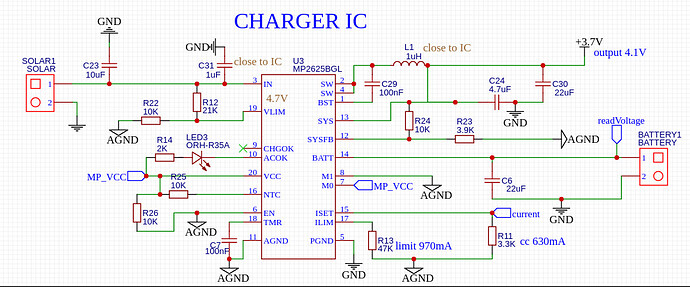Hi.
Im trying to design a charger for my project. Requirements are that should work with 5V 600mA solar panel and it should have power path with at least 2A output 4.1-4.3V. I was trying to find linear charger (for simplicity since my knowledge of electronics is very basic) but didn’t find one that meet the requirements.
So i stumble upon this one that meets the criteruim (im still open for suggestion thou) bit it seems quite complicated with the analog ground which is a new thing to me. So i tried to draw the the scheme around this IC and i would appreciate if someone could check if the scheme is correct.
-
If i regulate output voltage to 4.1V will it be regulated to this voltage even at night when there is no sun or output voltage will equal battery voltage? In that case i would probably connect analog pin of Atmega328 so i could measure the voltage of the battery.
-
I notice that different package size is used in capacitors. Is this requirement or can I use the same size, for example 1206?
You are probably overthinking the problem… I assume this is some form of IOT Device? 2A would be a peak not a constant? For an IOT Device consider 1:100 ratio solar to load (500mA supply, 0.5mA average load).
With a 5V 500mA cell, ( AliExpress/Ebay I presume… I have a few of these sitting around for projects at home!) you are never going to be able to supply to supply 4.1-4.3V at 2A. So it will always be the battery which can go directly to the load (no load switch required).
Depending on you battery, you might be able to do something very simple. NiCad - if you keep below C/20 - a diode and resistor will do. Li-Ion - Float Charge - limit the voltage to 4.03V (80%), again - simple BUT keep it below 4.1 V for longevity.
Alternatively, look at an energy harvester (MPS don’t make one from what I can see, someone may know of an app note). AliExpress/Ebay have a few of these on boards already, Charge a cap which charges a battery.
On the note about capacitors… SMD Ceramic Caps… Especially as the voltage goes up, the real value varies widely with voltage, so a 2.2uF, 50V 2220 has a much higher “real capacitance” than a 2.2uF 50V 1206 capacitor. For the small values (0603 or 0402 packages) you can always go up in package size, Where there is a filter, be careful to consider the voltage applied. At 5V this shouldn’t be an issue, but at 12 - 20V it can be significant.
Thank you for your feedback.
I’m making a weather station. Most of the time the station is just measuring data and using 0.5-30mA depending on the sensors used. But then every few minutes GPRS module SIM7000E is used to send the data. This module uses up to 2A current in bursts.
Currently Im using linear charger and I dont mind the efficiency but the problem is once the battery is full it stops using solar panel until the battery discharge a little bit. So what it happens is that battery keeps charging and discharging every few seconds which is probably not good for battery longevity.
So the only way i see to solve this is using charger with power path. This would mean that most of the time when there is enough sun solar could power the station. Even when sending data current typically doesn’t go above 100mA so it could still be powered by solar most of the time if not all the time.
Li ion batteries don’t actually like being charged at 4.1V. A proper charger will “float” the cell and only initiate a recharge once the cell has dropped by 100mV or so. Also the extra amount of energy from 3.8V to 4.1V is less than you think. I have read it is about 15% extra. The battery supposedly will last forever at 3.8V but held at 4.1V steadily ( if slowly) degrades. E cigarette forums for some weird reason seem to be a hotbed of DIY battery research.
For the weather station project, you need at least 2A output and 4.1-4.3V. As you mentioned your using solar panel arrangements to generate the required amount of energy.
I really appreciate you are trying to use renewable energy to generate power. At the same time, I understand your Challenge that solar battery is getting discharged very quickly.
There are two options that you can go with, one is to go with an alternative power option or increase the capacity of the solar panel by adding the more number of units to the system.
